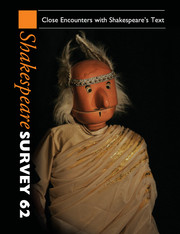Book contents
- Frontmatter
- Shakespeare, text and paratext
- The popularity of Shakespeare in print
- The continuing importance of new Bibliographical method
- ‘Honour the real thing’: Shakespeare, Trauma and Titus Andronicus in South Africa
- ‘O, these encounterers’: on Shakespeare’s meetings and partings
- A play of modals: Grammar and potential action in early Shakespeare
- Merry, marry, Mary: Shakespearian wordplay and Twelfth Night
- A subtle point: Sleeves, tents and ‘Ariachne’s broken woof’ (again)
- The look of Othello
- Red button Shakespeare
- ‘Mark you / his absolute shall?’: Multitudinous tongues and contested words in Coriolanus
- Chagall’s Tempest: An autobiographical reading
- Reading illustrated editions: Methodology and the limits of interpretation
- Close encounters with Anne Brontë's Shakespeare
- Shakespeare and the magic lantern
- Shakespeare and the coconuts: close encounters in post-apartheid South Africa
- The Schrödinger effect: Reading and misreading performance
- Behind the scenes
- Inner monologues: Realist acting and/as Shakespearian performance text
- More japanized, casual and transgender shakespeares
- Translation futures: Shakespearians and the foreign text
- After translation
- ‘The single and peculiar life’: Hamlet’s heart and the early modern subject
- Mapping King Lear
- ‘Last on the stage’: The place of Shakespeare in Charles Darwin’s ethology
- Sense/memory/sense-memory: Reading narratives of Shakespearian rehearsals
- Shakespeare performances in England (and Wales), 2008
- Professional Shakespeare productions in the British Isles, January–December 2007
- The Year's Contributions to Shakespearian Study 1 Critical Studies
- 2 Shakespeare in performance
- 3a Editions and textual studies
- 3b Editions and textual studies
- Index to Volume 62
Translation futures: Shakespearians and the foreign text
Published online by Cambridge University Press: 28 November 2009
- Frontmatter
- Shakespeare, text and paratext
- The popularity of Shakespeare in print
- The continuing importance of new Bibliographical method
- ‘Honour the real thing’: Shakespeare, Trauma and Titus Andronicus in South Africa
- ‘O, these encounterers’: on Shakespeare’s meetings and partings
- A play of modals: Grammar and potential action in early Shakespeare
- Merry, marry, Mary: Shakespearian wordplay and Twelfth Night
- A subtle point: Sleeves, tents and ‘Ariachne’s broken woof’ (again)
- The look of Othello
- Red button Shakespeare
- ‘Mark you / his absolute shall?’: Multitudinous tongues and contested words in Coriolanus
- Chagall’s Tempest: An autobiographical reading
- Reading illustrated editions: Methodology and the limits of interpretation
- Close encounters with Anne Brontë's Shakespeare
- Shakespeare and the magic lantern
- Shakespeare and the coconuts: close encounters in post-apartheid South Africa
- The Schrödinger effect: Reading and misreading performance
- Behind the scenes
- Inner monologues: Realist acting and/as Shakespearian performance text
- More japanized, casual and transgender shakespeares
- Translation futures: Shakespearians and the foreign text
- After translation
- ‘The single and peculiar life’: Hamlet’s heart and the early modern subject
- Mapping King Lear
- ‘Last on the stage’: The place of Shakespeare in Charles Darwin’s ethology
- Sense/memory/sense-memory: Reading narratives of Shakespearian rehearsals
- Shakespeare performances in England (and Wales), 2008
- Professional Shakespeare productions in the British Isles, January–December 2007
- The Year's Contributions to Shakespearian Study 1 Critical Studies
- 2 Shakespeare in performance
- 3a Editions and textual studies
- 3b Editions and textual studies
- Index to Volume 62
Summary
At the 1994 meeting of the International Shakespeare Conference in Stratford, Inga-Stina Ewbank delivered an impressive plenary devoted to 'Shakespeare and Translation as Cultural Exchange'. In this path-finding address, Ewbank observed that despite the cultural turn in Shakespeare studies, research into Shakespeare in translation was still mainly the pursuit of non-English-natives. Drawing on the work of Dirk Delabastita and Lieven D'hulst, Ewbank noted that - at least as perceived from the English omphalos - the study of translations was really 'an interesting and harmless occupation for researchers abroad'. There was, she argued, still little 'reciprocity' between Translation Studies on the one hand and English and American Shakespeare Studies on the other. During the early 1990s, seminars on translation had indeed become an inalienable part of Shakespeare conferences, in Stratford and elsewhere, but the attendance rate by native speakers of English, she argued, remained negligible.
Since 'Exchange' was the conference theme in 1994, Inga-Stina Ewbank sought to free Shakespearian translation from its Cinderella status and achieve a new, more fully integrated form of exchange around the topic. In an attempt to bring both non-native and native speakers of English together around their world author, Ewbank first countered the still widely held assumption that translation merely involved a potential element of corruption. Translation should not be seen as 'a somewhat embarrassing form of inverse colonialism' either. In an attempt to change this prevailing hegemonic perception, Ewbank invited the conference to recognize first of all that, '[t]ranslation is never a purely philological activity but a collusive re-creation in which cultural differences cling to grammar and syntax and history mediates the effect even of single words'.
- Type
- Chapter
- Information
- Shakespeare Survey , pp. 273 - 282Publisher: Cambridge University PressPrint publication year: 2009

